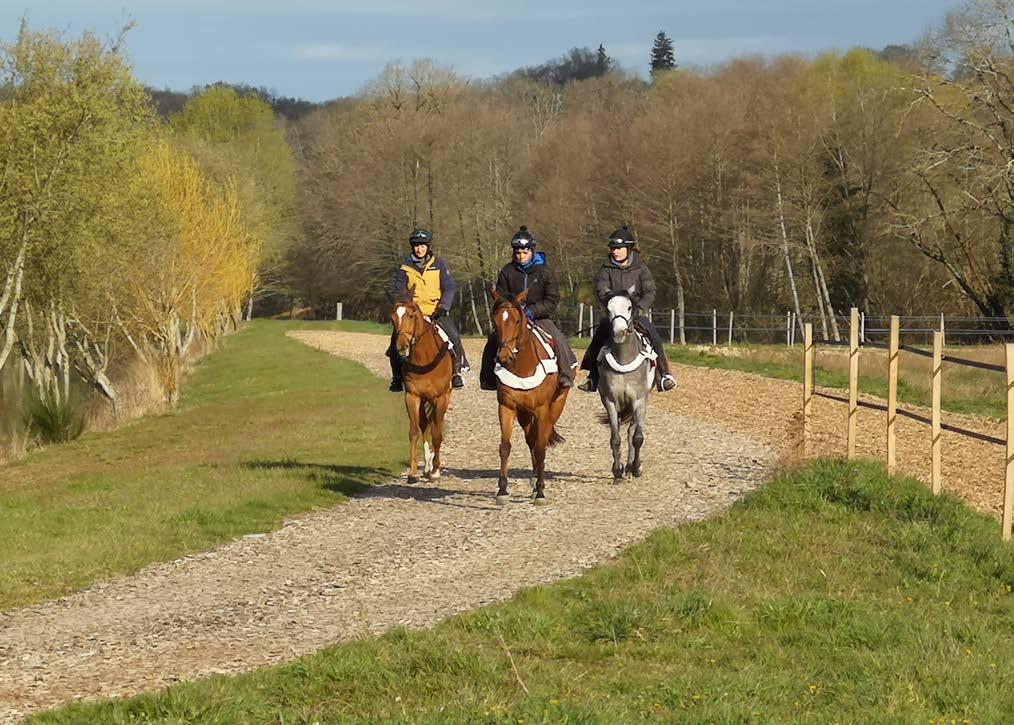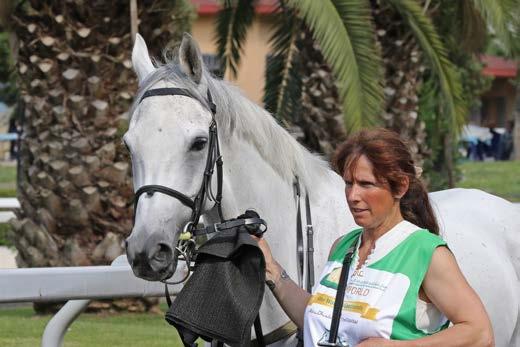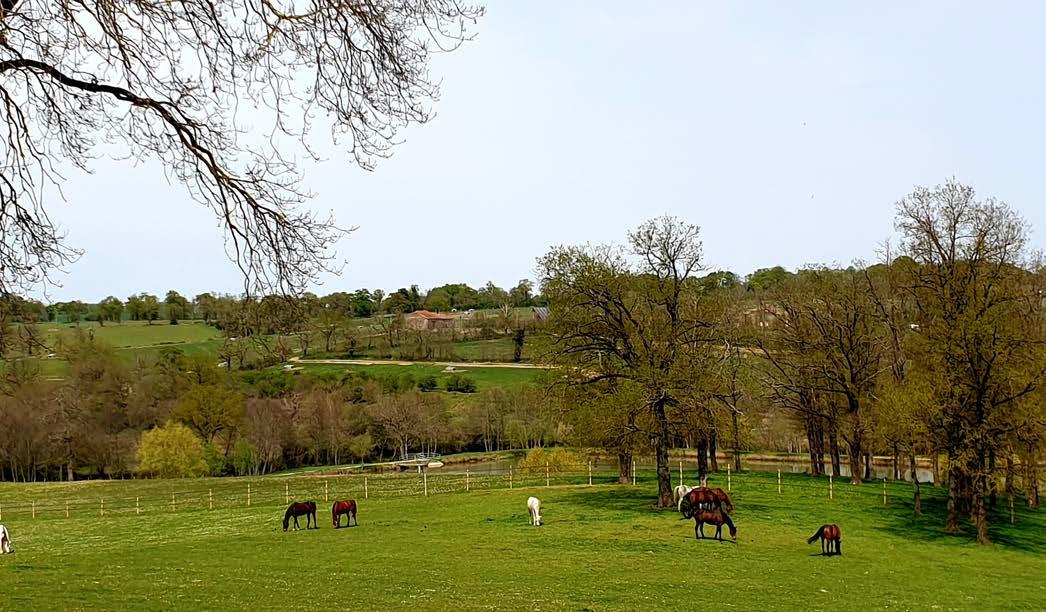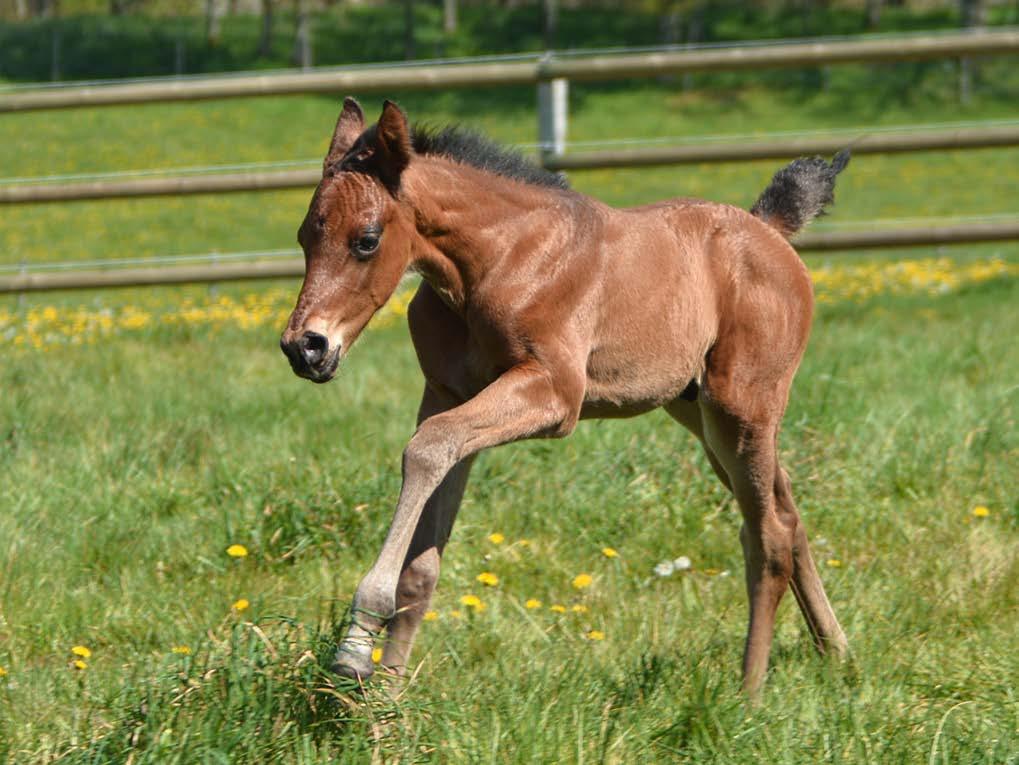
9 minute read
Nile Arabians - Stud & Training Focus
Nile Arabians at the Haras du Nil Limousin, France Stud & Trainer Focus
Previously based in Switzerland Nile Arabians have made relocation to France a smooth procedure and are looking forward to new challenges


Horses on the trotting ring at Haras du Nil
In 1976 Toni and Rita Aeschbacher, imported two straight Egyptian fillies to Switzerland and Nile Arabians was founded. The stud has grown to 26 horses and now includes several thoroughbreds, all cared for by their son Urs and his wife Franziska. At the beginning of 2019, after a long wait to find the right property, they relocated to France and after a year of hard work, the Haras du Nil is now fully established in the Limousin region. Urs and Franziska grew up around horses, riding from a young age in their native Switzerland. Later Urs competed warmbloods and Arabians in dressage and show-jumping, whilst Franziska brought on young show-jumpers for an international dealer. They met when Franziska completed an apprenticeship as a tourism consultant in the travel agency owned Urs’ father 36 years ago and have been together ever since.
Urs’s association with the Purebred Arabian began when he was just 12 years old with the Shagya stallion Hamilka. They developed a strong bond, giving freestyle presentations (without a saddle or bridle) in dressage and show jumping [pictured below]. He says: “Hamilka was my friend, we shared everything together. This was the moment when I fell in love with Arabian horses”. It was through Urs that Franziska was introduced to Arabians as she explains: “It was when I realised that A rabians are not only made for shows, but can be really good riding horses, I became interested in the breed.
Franziska riding Nil Ashal (SWI) in Switzerland “In the seventies and eighties the Arabian racing and endurance scene was not yet developed in Europe. As we liked

competitions, the only way to compete with Arabian horses was to participate in

shows.”

Franziska with Nil Ashal (SWI) for the Zayed Cup at Capanelle in Italy
In 1991, when Toni and Rita sold Nil Krushan (by Versal) to Paul Daverio, they soon broadened their interest to include racing as well. Daverio would later become the b reeder of multiple PA group winner Djet Taouy (by Dahess), however Nil Krushan was his first Purebred Arabian and he wanted him to be a riding horse. However, when Nil Krushan was four, Daverio rang the Aeschbacher’s and to tell them that their colt was to run in a
race at Frauenfeld in Switzerland.
Urs with Nil Alamoon (SWI) in Italy She recalls: “We all went to the races and saw for the first time, an Arabian race. Nil Krushan won easily and this was the start of our racing activities.”

They continued to observe their traditional pure Egyptian breeding programme whilst adding new inputs in the form of first-class stallions with Russian, Polish, French and Tunisian bloodlines. This established Nile Arabians as a source of success both in the show ring and on the race track. To date, horses bred or trained by Nile Arabians have won over 100 Show Champion and Best in Class prizes, including titles such as World and European Champion. Since they began to switch f ocus to racing, horses bred or trained by Nile Arabians have won 50 times up to Group 1 PA level.
When they lived in Switzerland they had to race in other European countries because there were never enough races in Switzerland. Franziska explains: “That gave us a good idea which level of horse can be competitive in each country. We have raced our Arabians in Italy, Belgium, the Netherlands and Germany.
“Now our aim is that our home-bred Arabian racehorses will be competitive in F rance, but the most important thing to do is to find the most suitable race for every horse, no matter in what country it is in. With our thoroughbreds it is different as we have regularly raced successfully in France during the last 15 years.”
Following Toni’s death, Rita was left to care for the breeding stock alone at Brenles, with Urs and Franziska schooling and training around 15 horses at the IENA training centre (National Equestrian Institute of Avenches). With these activities 3 5 km apart, it was obvious that they would need to move to combine all their activities in the same location. For Franziska, France was the obvious choice as she explains: “There are more races to choose from, with less costs to travel and so on. The prize money for the owners and breeders is better, not only for the Arabians, but the thoroughbreds too.”
She continued: “The climatic conditions in Limousin are better for breeding and training horses than at our previous f arms in Switzerland. The grass here is known for its good quality, thanks to the influence of the Atlantic Ocean the growing season is longer and during winter it seldom freezes.
Mares in the paddocks at the Haras du Nil in Limousin


Horses canter on the woodchip gallop
The Haras du Nil is situated between the Southwest of France, the home of Arabian racehorses, and the Normandie, the heart of the Thoroughbred breeding. Consequently, during the breeding season their Arabian and thoroughbred mares benefit from only having to travel short distances to get in foal. There is renowned clinic and reproduction centre within 15km of the stud and there are more than 40 race tracks within a radius of 200km.
Franziska notes that the Limousin region also h as a certain tradition in Arabian horse breeding and a historical connection to establishing horseracinbg as a sport in France. The Anglo-Arab breed was promoted from the Royal and later National Stud of Pompadour which had been founded in 1751. Pompadour was also famous for its Purebred Arabians, with stallions and still active successful dam lines. It was also in Limoges that Napoléon Bonaparte gave the permission to build one of the first race tracks of France in 1805, a hippodrome which still exists today.
They had been looking for a suitable property for quite a long time, however once they had found the right place, the move went very quickly. Completing their contract in August 2018, their 26 horses moved four months later from Switzerland to France. Thanks to their experiences of studs and training centers worldwide, they both had a clear vision of how to establish their new farm. Buying a former cattle farm meant that there was no existing e questrian infrastrucyre they could start from scratch. They found it was easy to realize their vision in a short space of time.
Urs’s mother Rita Aeschbacher, continued to run the stud farm until the very last day in Switzerland, but at 84 years she chose to stay behind and lives next to her daughter’s farm. She is still maintains an interest in Nile Arabians visiting regularly to see the foals and to monitor the progress of the older horses.
Whilst catering for their own stock, they now offer race and pre-race training for thoroughbreds and Arabians as well breaking and schooling of young horses for clients. They have 32 boxes, a sand paddock, a trotting track of about 400m and a 900m wood chip circle track with a diagonal 1200m straight canter track, which is uphill for the last 600m.
The light, mineral rich soils are ideal for horses and their 40 hectares are divided into large paddocks perfect for breeding and rearing and for the retired or convalescing horses. The racehorses are also able to benefit from daily turnout.
The Haras Du Nil has established two racing bloodlines, one is French out of the Pompadour family of Attique (by Meat), currently represented by Nil Abiat (by Darike) and Nil Anablue (by Munjiz), both are out of Kadjouna de Nerak (Djourman).
Listed winner Nil Kamla (by Dahess) represents their Tunisian line tracing back to the foundation mare Samaria, 1882, which was i mported 1887 from Syria to Pompadour and sold to the famous Tunisian stud Sidi Thabet in 1891. This dam line has many successful representatives, for example Group race horses such as Madjani (Tidjani), Nour Thabet (Dormane), Essaana (Tornado De Syrah) and Al Jakbar (Al Sakbe).
They wanted to include the blood of Nevada II (Djanor), so in 2019 they purchased a filly, by Al Tair (Amer) out of Fauvette Du Loup (Tornado De Syrah) and are hoping she will be lucky for them. Fauvette D u Loup is out of Caline Du Loup (Mangante) and is a great granddaughter
2020 colt by No Risk Al Maury (FR) x Nil Kamla (SWI)


Nil Aziz (SWI) wins the 2017 Zayed Cup (LRPA) at St Moritz


So far their most successful homebred is Nil Aziz (by Dahess), winner of the Listed PA Sheikh Zayed Cup on the snow at St Moritz, he was Listed placed a further three times there and in Italy. Retired from racing, he has since been sold to Endurance.
Looking to the future they have his halfbrother Nil Adamis (by Damis) in training, along with the three-year-old filly, Nil Farah Diba (by AF Albahar). There is also a twoyear-old filly out of Nil Kamla by Assy. This year they have four foals, two thoroughbreds, and two Arabians who are by No Risk Al Maury and by Mister Ginoux.
Asked what they look for in a horse and what faults they are prepared to accept, Franziska say: “For training and competing race horses, we can live almost with every deviation from the norm, with regard of personality and structure, as long as the horse is trainable, raceable and making regularly good results in races.
“With regard to our breeding activities we select well-balanced, sound and wellminded horses. We try to breed only with the best pedigrees available.” They agree that the biggest immediate challenge since they moved is to breed the standard of horse capable of competing successfully in France. As Franziska observes: “There are more races here than in other European countries, but there are also more internationally important breeders and owners who dominate the scene. Here there are no handicap races, so you must have a top horse - otherwise l ife will be very hard.”
Concluding she says:“From an European perspective the biggest problem we see is the fact that in most other European countries Arabian horse racing is almost non-existent. Even in countries like Germany, England or Italy the significance of Arabian horse racing is marginal compared with Thoroughbred racing. So for the future, the big challenge on a wider scale is to to build a larger and more active Arabian horse community with a good number of local breeders and owners of Arabian racehorses in each country.
www.nile-arabians.com
Additional photos supplied by Nile Arabians and Sheikh Mansoor Festival (St Moritz)









